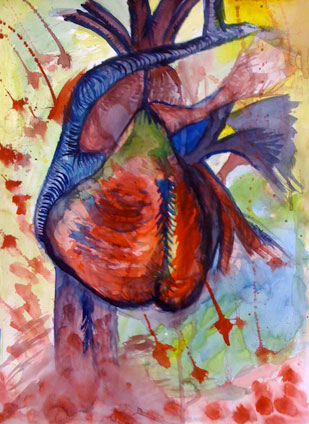
Watercolor painting by
Brittany Feedore
Brittany Feedore's watercolor learning experience:
I was not very knowledgeable about watercolors upon starting this course. I only knew the basics of watercolor. For example, I was already aware that white paint was not required to lighten colors. Water is the medium used to whiten colors. In addition, I knew it was easy to go from dark to light shades. Due to my lack of knowledge pertaining to this popular media, I decided to do a little historical research about watercolors.
Although watercolor painting is extremely old, dating back to cave paintings of paleolithic Europe, and has been used for manuscript illumination since at least Watercolor was a medium used first by cave men of the Paleolithic age, Egyptians and European Middle Ages. It was a popular medium during the Renaissance. The German artist, Albrecht Dürer (1471-1528), painted several fine botanical, wildlife and landscape watercolors. He is generally considered among the earliest exponents of the medium. An important school of watercolor painting in Germany was led by Hans Bol (1534-1593) as part of the Dürer Renaissance.
Despite this early start, watercolors were generally used by Baroque easel painters only for sketches, copies or cartoons (small scale design drawings). Among notable early practitioners of watercolor painting were Van Dyck (during his stay in England), Claude Lorrain, Giovanni Benedetto Castiglione, and many Dutch and Flemish artists. However, botanical and wildlife illustrations are perhaps the oldest and most important tradition in watercolor painting. Botanical illustrations became popular in the Renaissance, both as hand tinted woodblock illustrations in books or broadsheets and as tinted ink drawings on vellum or paper. Botanical artists have always been among the most exacting and accomplished watercolor painters, and even today watercolors, with their unique ability to summarize, clarify and idealize in full color, are used to illustrate scientific and museum publications. Wildlife illustration reached its peak in the 19th century with artists such as John James Audubon, and today many naturalist field guides are still illustrated with watercolor paintings.
My goal for this course is not to learn the history of watercolors. Rather, it is to learn the proper application of this medium. Still, it is important to know the historical significance of watercolors, so society can know why it is necessary to carry on the tradition of watercolor painting.
